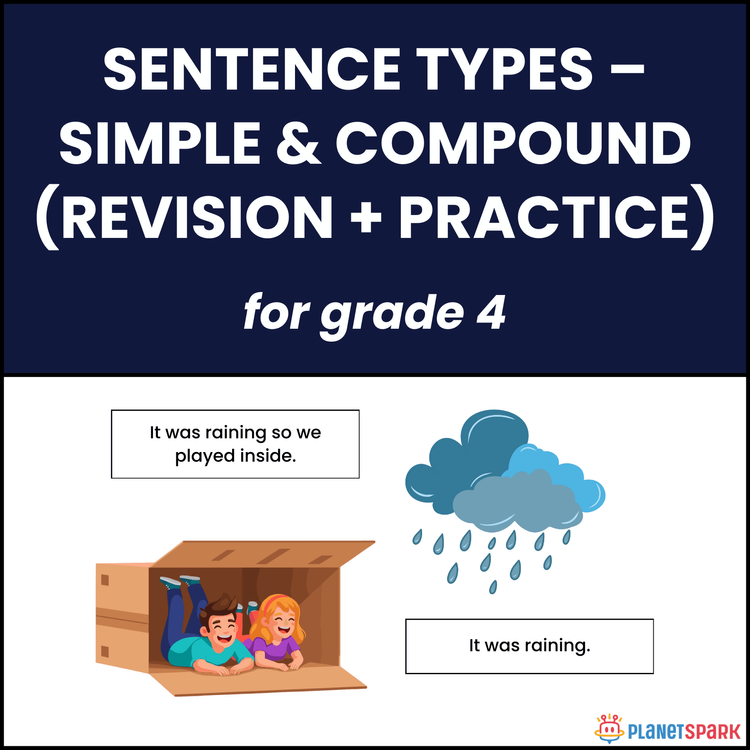10 Types of Verbs That a Class 5 Kid Must Know with Tips!

Table of Contents
- What Are Verbs?
- 10 Types of Verbs for Class 5
- Rules of Using Different Types of Verbs for Class 5
- How Learning Types of Verbs for Class 5 Helps Students
- Common Challenges and Tips in Learning Types of Verbs for Cl
- Importance of Verbs in Grammar
- How PlanetSpark Makes Learning Verbs Easy
- Conclusion
- Readers Also Read
- FAQs on Types of Verbs for Class 5
Learning the types of verbs for Class 5 is an important step in building strong grammar skills. Verbs make sentences meaningful by showing action, state, or condition. When children understand verbs, they can write better stories, frame correct sentences, and speak with confidence. At PlanetSpark, we believe grammar should be more than memorising rules.
In this blog, we’ll explore the 10 types of verbs for Class 5 with simple definitions and easy examples that every child can understand.
What Are Verbs?
Before we dive into the types of verbs for Class 5, let’s understand what a verb actually is.
A verb is a word that shows an action, state, or event. No sentence is complete without a verb. Every time we talk, we use verbs without even realising it.
✔️ Riya is dancing on stage. (Action)
✔️ My father is happy today. (State)
Fun fact: A verb can sometimes make a full sentence on its own! For example, if you say “Run!”, the subject “you” is understood, and the verb becomes a complete sentence by itself.
In short, verbs are the heartbeat of a sentence, and knowing their types will make grammar easier for students.
Want your child to master verbs with ease?
Join PlanetSpark’s Grammar Classes
10 Types of Verbs for Class 5
There are different types of verbs for Class 5 students that make English grammar easier to understand and use. Each type plays a special role in forming sentences. Let’s explore them one by one with definitions and examples.
1. Main Verbs (Action Verbs)
Main verbs, also known as action verbs, tell us what the subject is doing. They can show physical actions (like run, eat, write) or mental actions (like think, decide, remember).
Examples:
- The boy runs across the playground. (Physical action)
- I remember the story very well. (Mental action)
Why is it important?
Main verbs help children write strong sentences. Whether they are writing essays or telling stories, using the right action verb makes the sentence lively.
2. Auxiliary Verbs (Helping Verbs)
Auxiliary verbs support the main verb. They add meaning to the action, help form questions, and show tense or negative sentences. Common helping verbs include is, am, are, was, were, have, has, will, shall, can, may.
Examples:
- She is reading a book.
- I have finished my homework.
- Papa will buy mangoes tomorrow.
Why is it important?
Auxiliary verbs allow kids to frame grammatically correct sentences, especially when learning tenses.
3. Linking Verbs
Linking verbs do not show action. Instead, they connect the subject with more information about it. Words like is, am, are, was, were, seem, look, appear often act as linking verbs.
Examples:
- He is a good singer.
- The roses seem fresh.
- My brother looks tired.
Why is it important?
They help children describe people, places, and things more clearly in both writing and speaking.
4. Transitive Verbs
A transitive verb always has a direct object, the action is done to something or someone. Without an object, the sentence feels incomplete.
Examples:
- Rina wrote a letter. (Letter = object)
- The dog chased a cat. (Cat = object)
Why is it important?
These verbs show the link between the action and the receiver of the action. Kids learn how actions affect objects in a sentence.
5. Intransitive Verbs
Intransitive verbs do not need an object. The action is complete on its own.
Examples:
- The baby cried loudly.
- The children laughed at the joke.
Why is it important?
Children can learn to recognise when a sentence does not need an object. This helps avoid grammar mistakes.
Help your child shine in school with strong grammar skills.
Enroll for Free Trial
6. Regular Verbs
Regular verbs are easy to identify because they form their past tense by adding -d or -ed.
Examples:
- Walk → Walked
- Play → Played
- Laugh → Laughed
In sentences:
- Sita played with her dolls.
- He walked home after school.
Why is it important?
Most verbs in English are regular, so children will use them frequently in writing and speech.
7. Irregular Verbs
Irregular verbs do not follow the “-ed” rule. Their past tense changes completely.
Examples:
- Go → Went
- Eat → Ate
- Take → Took
In sentences:
- I went to the park yesterday.
- She took my pencil.
Why is it important?
Irregular verbs can be tricky. Learning them early helps kids avoid mistakes in essays, tests, and conversations.
8. Modal Verbs
Modal verbs express ability, possibility, necessity, or permission. They are special helping verbs. Common modal verbs: can, could, may, might, shall, should, must, will, would.
Examples:
- I can swim very fast. (Ability)
- You must complete your homework. (Necessity)
- She may come to the party. (Possibility)
- May I borrow your book? (Permission)
Why is it important?
Modal verbs teach children how to express rules, abilities, or requests politely.
9. Phrasal Verbs
A phrasal verb is made of a verb + preposition or adverb, and it usually has a different meaning from the original verb.
Examples:
- Get up (wake up)
- Look after (take care of)
- Give up (stop trying)
In sentences:
- Please get up early tomorrow.
- She looked after her little brother.
Why is it important?
Phrasal verbs are common in spoken English. Kids who understand them can communicate more naturally.
10. Stative Verbs
Stative verbs describe a state of being, condition, feeling, or possession. They usually don’t show action.
Examples:
- I love my school. (Emotion)
- She has a new bicycle. (Possession)
- We believe in honesty. (Opinion)
Why is it important?
These verbs help children express feelings, thoughts, and states clearly.

Learning verbs can be fun and interactive.
Explore PlanetSpark’s Online Classes
Rules of Using Different Types of Verbs for Class 5
Learning the types of verbs for Class 5 is not enough unless students know how to use them correctly. Here are some simple rules to remember:
Subject–Verb Agreement
Singular subjects take singular verbs, and plural subjects take plural verbs.
Example: She runs fast. / They run fast.
Tense Consistency
Verbs should follow the correct tense in a sentence.
Example: I am reading now. (Present Continuous) / I read every day. (Simple Present)
Use of Helping Verbs
Always pair auxiliary verbs with the main verb correctly.
Example: She is playing. / They have finished.
Avoid Double Verbs Without Need
Do not use two main verbs together without a connector.
❌ He go run fast.
✅ He goes to run fast.
Modal Verbs with Base Form
Modal verbs (can, may, must, should) are always followed by the base form of the verb.
Example: You should study. / He can swim.
By following these rules, students can confidently use different types of verbs in writing and speaking.
How Learning Types of Verbs for Class 5 Helps Students
Understanding the types of verbs for Class 5 is more than just memorising grammar rules. It builds a strong foundation for communication, writing, and overall language development. Here’s how it helps:
Improves Sentence Formation
Students learn how to frame clear and grammatically correct sentences.
Example: Instead of writing He running fast, they correctly write He is running fast.
Boosts Writing Skills
Essays, stories, and letters become more engaging when verbs are used effectively.
Example: The dog barked loudly sounds more powerful than The dog is loud.
Enhances Speaking Fluency
By practicing different verb forms, children become more confident in conversations and presentations.
Develops Logical Thinking
Choosing the right verb helps children understand cause and effect in communication.
Example: If it rains, we will stay inside.
Prepares for Higher Classes
A strong grasp of verbs at Class 5 level sets the stage for advanced grammar topics in middle school.
Reduces Common Errors
Mistakes like tense mismatch (She go to school yesterday) are avoided once children know the rules of verbs.
Give your child the confidence to speak and write fluently.
Sign Up for a Free Class
Common Challenges and Tips in Learning Types of Verbs for Class 5
| Challenges Students Face | Practical Tips to Overcome Them |
|---|---|
| Confusing regular and irregular verbs (e.g., go → went vs. play → played) | Use flashcards and verb lists; practice irregular verbs through fun games and worksheets. |
| Mixing up verb tenses in writing and speaking | Encourage daily practice by narrating daily routines in present, past, and future tense. |
| Overusing simple verbs like do, go, make | Introduce richer vocabulary through reading stories and highlighting strong action verbs. |
| Struggling with subject-verb agreement (He eat food instead of He eats food) | Give quick drills and oral exercises focusing on singular/plural usage. |
| Forgetting auxiliary verbs (is, are, have) in sentences | Teach with sentence-building games and fill-in-the-blank worksheets. |
| Difficulty applying verbs in longer sentences | Start with short sentences, then gradually increase complexity using conjunctions. |
| Learning rules but not applying them in real life | Encourage journal writing or short story creation where students must use different verb types. |
With guided practice and engaging activities, children not only learn types of verbs for Class 5 but also start applying them naturally in writing and speech.
Importance of Verbs in Grammar
Verbs are often called the engine of a sentence because they drive meaning. Without verbs, communication feels incomplete. For students, learning the types of verbs for Class 5 is more than just a grammar rule, it builds the foundation for effective writing, speaking, and understanding of English.
Here’s why verbs are so important:
They Show Action and State
Verbs tell us what a person, animal, or thing is doing (run, play, sing) or what state they are in (is, seem, feel). This makes sentences meaningful and clear.They Express Time
Verbs change with tense: past, present, and future. For example, play becomes played or will play. Mastering these changes helps children write accurate stories, essays, and answers.They Add Energy to Writing
Using rich verbs makes writing lively. Compare: He went to the park vs. He dashed to the park. Strong verbs make sentences more engaging and fun to read.They Build Communication Skills
When children understand verb types like helping verbs, linking verbs, and action verbs, they can form correct sentences and express ideas fluently. This boosts both written and spoken English.They Support Advanced Learning
Verbs are not just used in simple sentences. They play a key role in subject–verb agreement, active and passive voice, and complex sentence structures, which students will learn in higher grades.
In short, verbs are the building blocks of grammar. For Class 5 students, mastering them now ensures confidence in writing, storytelling, and public speaking in the years ahead.
How PlanetSpark Makes Learning Verbs Easy
Learning the types of verbs for Class 5 can feel tricky for many students if taught only through textbooks. At PlanetSpark, we turn grammar into an interactive journey where children not only understand verbs but also use them in real conversations and writing.
Our classes focus on:
Learning through stories and role-plays: children practice verbs in everyday situations, which makes grammar practical.
Fun grammar games and worksheets: instead of rote memorisation, kids engage with verbs through quizzes, puzzles, and group activities.
Step-by-step learning: students move from identifying verbs to applying them in sentences, essays, and spoken English.
Confidence-building activities: public speaking tasks and creative writing exercises help kids use verbs naturally.
Personalised feedback: teachers track progress and guide children in mastering tenses, helping verbs, and action words with clarity.
By the end of the program, students don’t just know the rules of verbs, they use them confidently in both academics and everyday communication.
Conclusion
Mastering the types of verbs for Class 5 is more than just a grammar lesson, it is a stepping stone to confident communication. Verbs bring sentences to life by showing action, expressing states, or connecting ideas. When students understand how to use different kinds of verbs, they write more accurately, speak more fluently, and perform better in academics.
Readers Also Read
FAQs on Types of Verbs for Class 5
Q1. What are verbs in English grammar?
Verbs are words that show action, state of being, or help connect ideas in a sentence. Examples include run, eat, is, was, and will.
Q2. How many types of verbs are taught in Class 5?
Class 5 students usually learn about action verbs, linking verbs, helping verbs, transitive verbs, intransitive verbs, regular verbs, and irregular verbs.
Q3. Why is it important to learn the types of verbs for Class 5?
It helps students form correct sentences, improve their writing, and express ideas more clearly. It also strengthens their foundation for higher-level grammar.
Q4. What is the difference between regular and irregular verbs?
Regular verbs follow a fixed rule when forming past tense (e.g., play → played), while irregular verbs change form completely (e.g., go → went).
Q5. How can students practice verbs effectively?
They can use worksheets, sentence-making exercises, storytelling, and everyday conversations to strengthen their understanding of verbs.
Q6. Which type of verb is the most common in Class 5 grammar?
Action verbs are the most common since they describe what a person, animal, or thing does.
Q7. How do helping verbs support main verbs?
Helping verbs (like is, was, will, can, should) work with the main verb to show tense, mood, or possibility. Example: She is running fast.
Download Free Worksheets
Personalized Communication Report
Record a video to get a AI generated personalized communication report for your child

Hi There, want to try these
tips for your child with
LIVE with our expert coach?
Let's check your child's
English fluency


